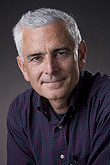Has dark matter been detected?
Craig Hogan, director of the Center for Particle Astrophysics, wrote this week’s column.
 |
|
Craig Hogan
|
We have been on the hunt for dark matter for a long time. It’s an elusive quarry. Many different lines of evidence, based on gravitational interactions of galaxy-size swarms of matter, indicate that most of the universe is made of a new kind of nearly noninteracting, relatively slow-moving particle. But experiments so far have found neither signals of individual dark matter particles nor any data that hint at even the most basic properties of those particles, such as their mass.
That’s why a lot of people are talking about a paper submitted recently by Dan Hooper, a Fermilab theorist, with a graduate student, Lisa Goodenough. They analyzed data from the Fermi Gamma-ray Space Telescope and found evidence for an unusual source of gamma rays near the center of our galaxy, the Milky Way.
The spectrum of this source is unusual: Most of its power is concentrated in a band of energy between 2 and 4 GeV, unlike the more spread-out power-law spectrum characteristic of astrophysical gamma-ray emission. And although the source is concentrated near the center of our galaxy, it’s not a point, but is spread out across about a degree in the sky.
Remarkably, this is just what we expect if dark matter particles that make up most of the Milky Way’s mass have a mass of about 7 GeV, and come in matter and antimatter versions that occasionally annihilate. They destroy each other and convert by various channels into observable gamma rays. In other words, our galaxy’s halo may not be dark after all, but very faintly glowing. The glow is brightest near our galaxy’s center because that’s where the dark matter particles are closest together and collide with each other most easily.
It’s tantalizing that the same dark matter particle mass can also explain data from two underground experiments known by their acronyms, DAMA and CoGeNT. Some of their signals may have been caused by direct collisions of dark matter particles with atomic nuclei in the laboratory.
Could this finally be the long-awaited detection of dark matter? Maybe, but we won’t know for a while yet. Physicists will analyze Fermi’s gamma-ray signal in more detail to see if it is really consistent with dark matter annihilating, or whether there is evidence for a less exotic, unfamiliar astrophysical process involving only already-known particles. Physicists also will re-examine underground experiments in new ways and in some cases perhaps even reconfigure them to operate with greater sensitivity to the mass range of about 7 GeV, a considerably lower mass region than most experiments have focused on up to now.
New developments may unfold quickly, even over the course of the next months, so it will be an exciting time. At Fermilab, we’ll work hard to disprove the Hooper/Goodenough claim--- because that’s also the best way to convince ourselves that it might be true.
|